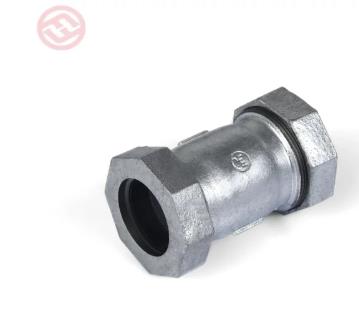A long compression coupling creates a watertight seal between two pipes by utilizing a compression mechanism.
Design: A long compression coupling typically consists of two halves or shells that encase the pipe ends to be joined. These halves are usually made of durable materials like brass or stainless steel.
Gasket: Inside the coupling, there is a gasket or sealing ring made of rubber or another elastomeric material. The gasket is designed to provide a tight seal between the pipe ends.
Compression Nut and Bolts: The two halves of the coupling are held together by a compression nut and bolts. These components apply pressure to the coupling, compressing the gasket against the pipe ends.
Installation: To create a watertight seal, the long compression coupling is placed over the two pipe ends that need to be joined. The pipes should be clean and free from debris. The coupling halves are aligned, and the compression nuts are tightened onto the bolts.
Compression: As the compression nuts are tightened, the coupling halves are drawn closer together. This compresses the gasket, causing it to deform and create a tight seal around the pipe ends.
Sealing Effect: The compression of the gasket creates radial pressure on the pipe ends, effectively sealing any gaps or irregularities. The gasket forms a barrier that prevents water or other fluids from leaking out of the joint.
Watertightness: The combination of the compression force and the properties of the gasket material ensures a secure and watertight seal between the pipes. The compression coupling is designed to withstand normal operating pressures and maintain its sealing integrity over time.
It's important to follow the manufacturer's instructions and guidelines when installing a long compression coupling to ensure proper sealing and joint integrity. Additionally, regular inspection and maintenance of the coupling can help identify any potential issues and ensure continued watertightness.
Long compression couplings are commonly used in various applications and scenarios where a secure and watertight connection between pipes is required. Here are some common applications:
Plumbing Systems: Long compression couplings are widely used in plumbing systems for both residential and commercial buildings. They are employed to join and repair pipes carrying water, such as supply lines, distribution pipes, or drainage systems.
Irrigation Systems: In agricultural and landscaping applications, long compression couplings are used to connect pipes in irrigation systems. They provide a reliable and leak-free connection for water distribution to sprinklers, drip lines, Long Compression Coupling or other irrigation components.
HVAC (Heating, Ventilation, and Air Conditioning) Systems: Long compression couplings are utilized in HVAC systems for connecting pipes carrying water or refrigerant. They are commonly used in hydronic systems, chilled water systems, or refrigerant lines.
Industrial Piping: Long compression couplings find use in industrial settings where pipes need to be joined securely and efficiently. They are employed in various industries such as manufacturing, chemical processing, or power generation.
Municipal Water and Sewer Systems: Long compression couplings are utilized in municipal water supply and sewer systems. They are used to connect pipes in underground infrastructure, including water mains, distribution lines, or sewer pipelines.
Pool and Spa Plumbing: Long compression couplings are used in pool and spa plumbing systems for connecting pipes that carry water to and from the pool or spa equipment. They ensure a tight and reliable connection, preventing leaks and maintaining proper water circulation.
Agricultural Applications: Long compression couplings are employed in agricultural setups for various purposes. They are used in irrigation systems for crop irrigation, livestock watering, or greenhouse applications.
DIY Plumbing Repairs: Long compression couplings are often used in do-it-yourself (DIY) plumbing repairs and installations. They provide a convenient and easy-to-use solution for connecting pipes without the need for soldering or specialized tools.
These are just a few examples of the applications where long compression couplings are commonly used. The versatility and reliability of these couplings make them suitable for a wide range of pipe connection needs across different industries and settings.

Copyright:@2020-2021
Comments Please sign in or sign up to post.
0
0 of 500 characters used